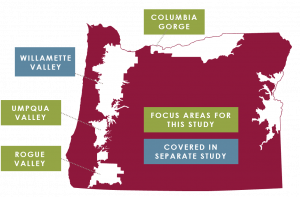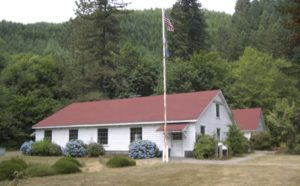By Aniko Drlik-Muehleck
Wineries and vineyards are an important source of economic activity in Oregon, particularly in rural areas where vineyards and many tasting rooms are located. Full Glass Research estimated that in 2016, Oregon’s wine industry contributed $5.6 billion to the state’s economy, supporting around 30,000 jobs that paid around $1 billion in wages.
 So who are the visitors contributing to Oregon’s wine economy? And what else are they doing – dining out, spending the night, shopping, recreating? Thanks to Travel Oregon and the Oregon Wine Country Plates Matching Grant, IPRE partnered with the Oregon Wine Board to answer these questions. Our recently released report details the behaviors, preferences, spending, and perceptions of visitors to wineries in the Rogue Valley, Umpqua Valley, and Columbia Gorge. Check out the findings in Oregon’s first Winery Visitor Profile.
So who are the visitors contributing to Oregon’s wine economy? And what else are they doing – dining out, spending the night, shopping, recreating? Thanks to Travel Oregon and the Oregon Wine Country Plates Matching Grant, IPRE partnered with the Oregon Wine Board to answer these questions. Our recently released report details the behaviors, preferences, spending, and perceptions of visitors to wineries in the Rogue Valley, Umpqua Valley, and Columbia Gorge. Check out the findings in Oregon’s first Winery Visitor Profile.
In addition to painting a detailed picture of Oregon’s winery visitors, the report also offers seven key findings that wine and travel industry professionals should consider as they promote Oregon’s wine and wine regions:
- Agritourism & Wine Tourism: Wine tourism complements Oregon’s emerging agritourism sector
- Visitor Experience: Winery visitors often prioritize experience over wine
- Inclusive Experiences: Offer more inclusive experiences at tasting rooms
- Millennials: Focus more marketing attention on Millennials
- Uniquely Oregon: Continue to foster and elevate a uniquely Oregon brand
- Staff & Hospitality: Winery staff can make or break a positive winery experience
- Collaboration: Oregon’s wine and tourism industries benefit from collaboration
This study provides a source of uniform and detailed data previously unavailable at a regional scale. This information will allow data-driven decisions about destination development and marketing with the goal of increasing visitation or Oregon’s wine regions and visitors’ satisfaction with their experiences. Ultimately, this work will contribute to Oregon’s economic development, particularly benefiting the often economically struggling rural areas where wine tourism is centered.
You can also view the press release and report on the Oregon Wine Board’s website. For more information about Willamette Valley winery visitors, check out a parallel study: Profile of Wine Tourists to the Willamette Valley.



